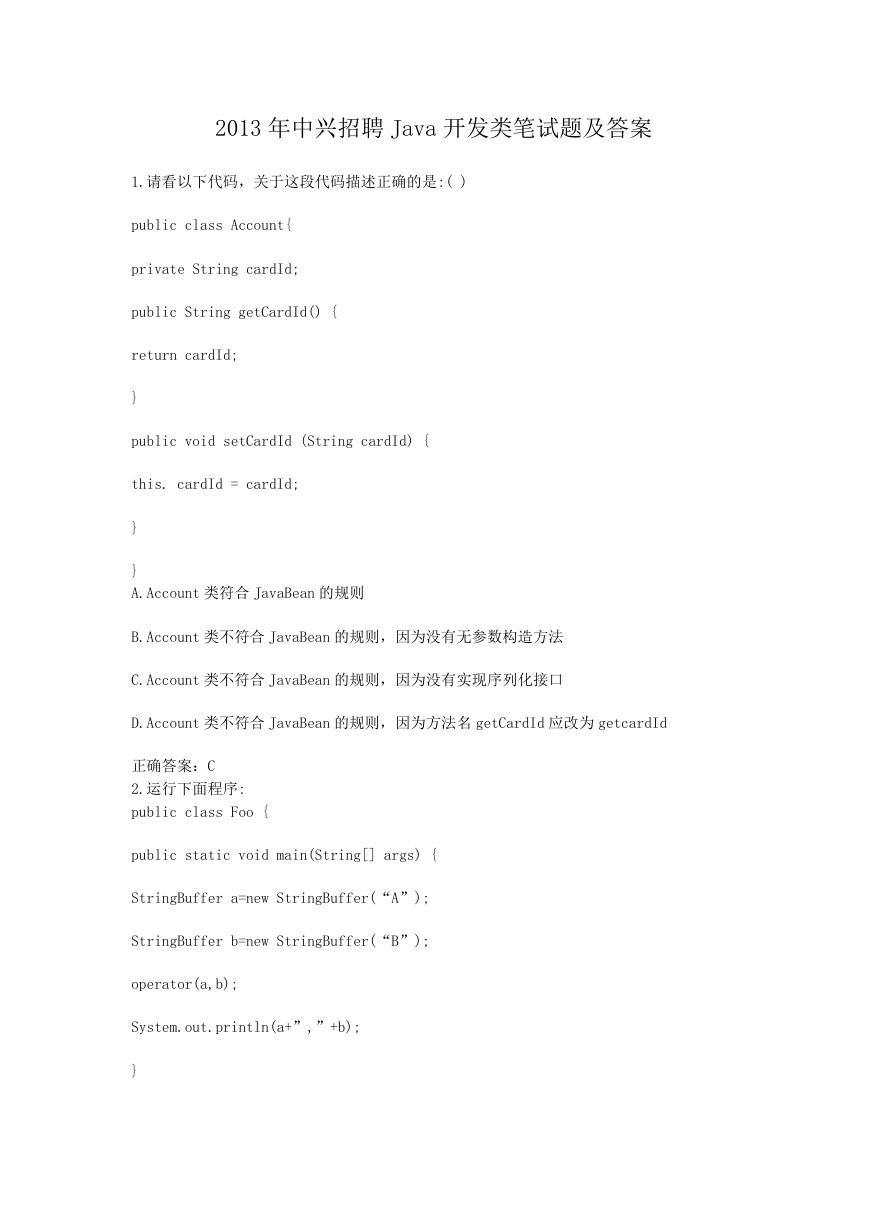2013 年中兴招聘 Java 开发类笔试题及答案
1.请看以下代码,关于这段代码描述正确的是:( )
public class Account{
private String cardId;
public String getCardId() {
return cardId;
}
public void setCardId (String cardId) {
this. cardId = cardId;
}
}
A.Account 类符合 JavaBean 的规则
B.Account 类不符合 JavaBean 的规则,因为没有无参数构造方法
C.Account 类不符合 JavaBean 的规则,因为没有实现序列化接口
D.Account 类不符合 JavaBean 的规则,因为方法名 getCardId 应改为 getcardId
正确答案:C
2.运行下面程序:
public class Foo {
public static void main(String[] args) {
StringBuffer a=new StringBuffer(“A”);
StringBuffer b=new StringBuffer(“B”);
operator(a,b);
System.out.println(a+”,”+b);
}
�
public static void operator(StringBuffer x,StringBuffer y){
x.append(y);
y=x;
}
}
输出的结果是:()。
A.A,B
B.A,A
C.B,B
D.AB,B
正确答案:D
3.下面的程序可以输出 1~100 内前 10 个 3 的倍数:
for (int i = 1, count = 0; i < 100; i++) {
if (i % 3 == 0) {
System.out.println(i);
(空白处)
}
}
下列选项中,空白处可以填入的代码是()。
A. if (count++ >= 10) {
break;
}
B. if (++count >= 10) {
break;
}
C. if (count++ >= 10) {
continue;
}
D. if (++count >= 10) {
continue;
}
正确答案:B
4.运行下面程序:
String[] strArr = { “aaa”, “b”, “cc” };
�
Arrays.sort(strArr, new Comparator() {
public int compare(String o1, String o2) {
return o2.compareTo(o1);
}
});
System.out.println(Arrays.toString(strArr));
输出的结果是:()。
A.[aaa, b, cc]
B.[cc, b, aaa]
C.[b, cc, aaa]
D.[aaa, cc, b]
正确答案:B
5. 对数组 int[] arr = { 52, 93, 16, 67, 36, 92, 26, 12, 25, 92 }用插入排序法由小
到大进行排序,经过 3 轮排序后,数组 arr 的值为:()。
A. {12,16,25,52,93,26,67,36,92,92}
B. {12,16,25,67,36,92,26,52,93,92}
C. {16,52,67,93,36,92,26,12,25,92}
D. {16,36,52,67,93,92,26,12,25,92}
正确答案:C
6.下列代码的输出结果是:()。
public class StaticFoo {
int num;
static int x;
public static void main(String[] args) {
StaticFoo foo1 = new StaticFoo ();
foo1.num++;
foo1.x++;
StaticFoo foo2 = new StaticFoo ();
foo2.num++;
�
foo2.x++;
StaticFoo foo3 = new StaticFoo ();
foo3.num++;
foo3.x++;
StaticFoo.x++;
System.out.print(foo3.num+”,”);
System.out.println(foo3.x);
}
}
A.3,3
B.1,3
C.3,4
D.1,4
正确答案:D
7.下列代码编译和运行的结果是()
public class Foo {
public static void main(String[] args) {
java.util.List
list = new java.util.ArrayList();
list.add(new B());
list.add(new C());
for (A a : list) {
a.x();
a.y();
}
}
�ClassA p4 = new ClassC();
<插入代码>
}
}
可以在<插入代码>处,填入的代码正确的是()
A.p0 = p1;
B.p1 =p2;
C.p2 = p4;
D.p2 = (ClassC)p1;
正确答案:A
9. 运行下面的语句:
System.out.println(Math.round(3.5) + ” ” + Math.floor(3.5) + ” ”
+ Math.ceil(3.5) + ” ” + Math.round(-3.5) + ” ”
+ Math.floor(-3.5) + ” ” + Math.ceil(-3.5));
输出的结果是:()。
A. 4 3.0 4.0 -3 -3.0 -4.0
B. 4 3.0 4.0 -4 -3.0 -4.0
C. 4 4.0 3.0 -4 -4.0 -3.0
D. 4 3.0 4.0 -3 -4.0 -3.0
正确答案:D
10. 下列赋值语句中,正确的是()。
A. byte b1 = 10, b2 = 20;
byte b=b1+b2;
B. byte b1 = 10, b2 = 20;
byte b=~b1;
C. byte b1 = 10, b2 = 20;
byte b=b1>>1;
D. byte b1 = 10;
byte b=++b1;
正确答案:D
11.类 Super 及 Sub 定义如下:
public class Super {
private void f() {
System.out.println(“Super.f()”);
}
public void g() {
�
f();
}
public void k() {
f();
}
}
public class Sub extends Super {
private void f() {
System.out.println(“Sub.f()”);
}
public void k() {
f();
}
}
运行下列语句:
Super obj = new Sub();
obj.g();
obj.k();
输出的结果是:()。
A. Sub.f()
Sub.f()
B. Sub.f()
Super.f()
C. Super.f()
Sub.f()
D. Super.f()
Super.f()
正确答案:C
12.下列代码的输出结果是()
public static void main(String[] args) {
String test = “a1b2c3″;
String[] tokens = test.split(“\\d”);
�
for (String s : tokens)
System.out.print(s + ” “);
}
A.a b c
B.1 2 3
C.a1b2c3
D.a1 b2 c3
正确答案:A
13.运行下列程序:
String str = “**java***java*****java*”;
String str1 = “java”;
int index = 0;
while ((index = str.indexOf(str1, index)) != -1) {
System.out.print(index+””);
index += str1.length();
}
控制台输出的结果是:()。
A. 1 8 17
B. 2 9 18
C. 5 12 21
D. 6 13 22
正确答案:B
14.运行下面程序:
public class Foo{
public static void main(String[] args) {
try {
test();
System.out.println(“condition 1″);
} catch (ArrayIndexOutOfBoundsException e) {
System.out.println(“condition 2″);
} catch (Exception e) {
System.out.println(“condition 3″);
�
















 2023年江西萍乡中考道德与法治真题及答案.doc
2023年江西萍乡中考道德与法治真题及答案.doc 2012年重庆南川中考生物真题及答案.doc
2012年重庆南川中考生物真题及答案.doc 2013年江西师范大学地理学综合及文艺理论基础考研真题.doc
2013年江西师范大学地理学综合及文艺理论基础考研真题.doc 2020年四川甘孜小升初语文真题及答案I卷.doc
2020年四川甘孜小升初语文真题及答案I卷.doc 2020年注册岩土工程师专业基础考试真题及答案.doc
2020年注册岩土工程师专业基础考试真题及答案.doc 2023-2024学年福建省厦门市九年级上学期数学月考试题及答案.doc
2023-2024学年福建省厦门市九年级上学期数学月考试题及答案.doc 2021-2022学年辽宁省沈阳市大东区九年级上学期语文期末试题及答案.doc
2021-2022学年辽宁省沈阳市大东区九年级上学期语文期末试题及答案.doc 2022-2023学年北京东城区初三第一学期物理期末试卷及答案.doc
2022-2023学年北京东城区初三第一学期物理期末试卷及答案.doc 2018上半年江西教师资格初中地理学科知识与教学能力真题及答案.doc
2018上半年江西教师资格初中地理学科知识与教学能力真题及答案.doc 2012年河北国家公务员申论考试真题及答案-省级.doc
2012年河北国家公务员申论考试真题及答案-省级.doc 2020-2021学年江苏省扬州市江都区邵樊片九年级上学期数学第一次质量检测试题及答案.doc
2020-2021学年江苏省扬州市江都区邵樊片九年级上学期数学第一次质量检测试题及答案.doc 2022下半年黑龙江教师资格证中学综合素质真题及答案.doc
2022下半年黑龙江教师资格证中学综合素质真题及答案.doc